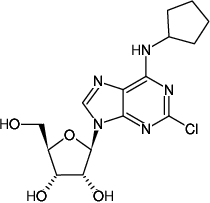2-Chloro-N6-cyclopentyl-adenosine
CCPA
2-Chloro-N-cyclopentyl-adenosine
| Catálogo Nº | Apresentação | Preço (R$) | Comprar / Observação |
|---|---|---|---|
| N-1079 | 200 μl (1 mM) | Sob demanda | Adicionar ao Carrinho |

For research use only!
Envio: shipped at ambient temperature
Condições de armazenamento: store at 4 °C
Short term exposure (up to 1 week cumulative) to ambient temperature possible.
Validade: 24 months after date of delivery
Fórmula molecular: C15H20ClN5O4
Peso molecular: 369.80 g/mol
CAS#: 37739-05-2
Pureza: ≥ 95 % (HPLC)
Forma: solution in DMSO
Concentração: 1 mM
Formulários:
Binding studies, physiological studies on cell cultures or tissues and in animal experiments.
Potent and highly selective A1-receptor agonist.
Usage: Dissolve stock solution with aqueous physiological buffer recommended for displacement studies, biochemical signal transduction studies or animal experiments.
To avoid biological effects of DMSO dilute the stock solutions with aqueous buffers to a content of DMSO below 1 %.
Please note: Stable in acidic and neutral buffer solutions for one day
Referências selecionadas:
Hasko et al. (2007) Shaping of monocyte and macrophage function by adenosine receptors. Pharmacol.& Therapeutics 113:264.
Ishiwata et al. (2007) PET tracers for mapping adenosine receptors as probes for diagnosis of CNS disorders. Central Nervous System Agents in Medicinal Chemistry 7:57.
Nemeth et al. (2007) Adenosine receptor activation ameliorates type 1 diabetes. FASEB J. 21:2379.
Joshi et al. (2005) Purine derivatives as ligands for A3 adenosine receptors. Current Topics in Medicinal Chemistry 5:1275.
Nemeth et al. (2005) Adenosine augments IL-10 production by macrophages through an A2B receptor-mediated posttranscriptional mechanism. J. Immunology 175:8260.
Wittendorp et al. (2004) The mouse brain adenosine A1 receptor: functional expression and pharmacology. Europ. J. Pharmacol. 487:73.
Jacobson et al. (2001) Ribose modified nucleosides and nucleotides as ligands for purine receptors. Nucleosides, Nucleotides & Nucleic Acids 20 (4):333.
Klotz (2001) Adenosine receptors and their ligands. Naunyn Schmiedebergs Arch. Pharmacol. 362:382.
Merighi et al. (2001) Pharmacological and biochemical characterization of adenosine receptors in the human malignant melanoma A375 cell line. Brit. J. Pharmacol. 134:1215.
Klotz et al. (1998) Comparative pharmacology of human adenosine receptor subtypes – characterization of stable transfected receptors in CHO cell. Naunyn-Schmiedeberg's Arch. Pharmacol. 357:1.
Monopoli et al.(1994) Pharmacology of the highly selective A1 adenosine receptor agonist 2-chloro-N6-yclopentyladenosine. Arzneimittelforschung 44 (12):1305.
Concas et al. (1993) Anticonvulsant doses of 2-chloro-N6-cyclopentyladenosine, an adenosine A1 receptor agonist, reduce GABAergic transmission in different areas of the mouse brain. J. Pharmacol. Exp. Ther. 267 (2):844.
Lohse et al. (1988) 2-Chloro-N6-cyclopentyladenosine: a highly selective agonist at A1 adenosine receptors. Naunyn Schmiedebergs Arch. Pharmacol. 337:687.
